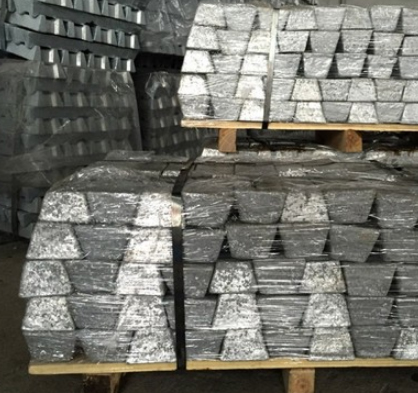99.99% Cadmium Metal
Cadmium is a toxic transition metal with soft
silver-white nature. Its chemical symbol is Cd and its atomic number is
48. , Melting point 320.9℃, boiling point 765℃, density 8.650 kg/m3;.
There is toughness and ductility. Cadmium slowly oxidizes in humid air
and loses its metallic luster. When heated, a brown oxide layer is
formed on the surface. Cadmium reacts fiercely with halogen at high
temperature to form cadmium halide. It can also be directly combined
with sulfur to generate cadmium sulfide. Cadmium is soluble in acid but
insoluble in alkali. The oxidation state of cadmium is +1. +2. The
solubility of cadmium oxide and cadmium hydroxide is very small. They
are soluble in acid but insoluble in alkali. Cadmium can form a variety
of ligand ions, such as Cd(NH3), Cd(CN), CdCl, etc. Cadmium is more
toxic, and air and food polluted by cadmium are seriously harmful to
humans.
Uses: used for electroplating, alloy manufacturing, etc.; and can be
made into neutron absorption rods in atomic reactors. Cadmium has a high
oxidation potential, so it can be used as a protective film for iron,
steel, and copper, widely used in electroplating, and used in
rechargeable batteries, TV picture tubes, yellow pigments, and as a
stabilizer for plastics. Cadmium compounds can be used in the
manufacturing of pesticides, fungicides, pigments, paints, etc.
In order to prevent cadmium poisoning, places where cadmium and its
compounds are smelted and used should have good ventilation and airtight
devices. In addition to the necessary ventilation equipment for welding
and electroplating processes, personal gas masks should be worn during
operation. Eating and smoking should not be allowed in the production
site. The high allowable concentration of cadmium oxide in production
sites in China is 0.1mg/m3.
Cadmium has an atomic number of 48 and an atomic weight of 112.411. The
name of the element is derived from Latin, and the original meaning is "magnesite".
Cadmium is a relatively rare element, and the content in the earth's
crust is about two hundred thousandths. Cadmium exists in the form of
compounds in nature, mainly sulfur cadmium ore. There are 8 natural
isotopes of cadmium: cadmium 106, 108, 110, 111, 112, 113, 114, 116.
Cadmium is a blue-white soft toxic transition metal with a density of
8.642 g/cm3. Slightly harder than tin, softer than zinc, toughness and
ductility. Cadmium is very stable in dry air, and the surface is covered
with oxide film in humid air. It forms brown oxide when it is red hot
and produces red flame when it burns. Cadmium and halogen react
violently at high temperature to form cadmium halide; it can be directly
combined with sulfur to synthesize sulfide Cadmium; can be dissolved in
acid to form the corresponding salt, but insoluble in strong alkali.
Main application: used for electroplating, alloy manufacturing, paint,
enamel paint, glass and other pigments.

.
Cadmium is a toxic transition metal with soft
silver-white nature. Its chemical symbol is Cd and its atomic number is
48. , Melting point 320.9℃, boiling point 765℃, density 8.650 kg/m3;.
There is toughness and ductility. Cadmium slowly oxidizes in humid air
and loses its metallic luster. When heated, a brown oxide layer is
formed on the surface. Cadmium reacts fiercely with halogen at high
temperature to form cadmium halide. It can also be directly combined
with sulfur to generate cadmium sulfide. Cadmium is soluble in acid but
insoluble in alkali. The oxidation state of cadmium is +1. +2. The
solubility of cadmium oxide and cadmium hydroxide is very small. They
are soluble in acid but insoluble in alkali. Cadmium can form a variety
of ligand ions, such as Cd(NH3), Cd(CN), CdCl, etc. Cadmium is more
toxic, and air and food polluted by cadmium are seriously harmful to
humans.
Uses: used for electroplating, alloy manufacturing, etc.; and can be
made into neutron absorption rods in atomic reactors. Cadmium has a high
oxidation potential, so it can be used as a protective film for iron,
steel, and copper, widely used in electroplating, and used in
rechargeable batteries, TV picture tubes, yellow pigments, and as a
stabilizer for plastics. Cadmium compounds can be used in the
manufacturing of pesticides, fungicides, pigments, paints, etc.
In order to prevent cadmium poisoning, places where cadmium and its
compounds are smelted and used should have good ventilation and airtight
devices. In addition to the necessary ventilation equipment for welding
and electroplating processes, personal gas masks should be worn during
operation. Eating and smoking should not be allowed in the production
site. The high allowable concentration of cadmium oxide in production
sites in China is 0.1mg/m3.
Cadmium has an atomic number of 48 and an atomic weight of 112.411. The
name of the element is derived from Latin, and the original meaning is "magnesite".
Cadmium is a relatively rare element, and the content in the earth's
crust is about two hundred thousandths. Cadmium exists in the form of
compounds in nature, mainly sulfur cadmium ore. There are 8 natural
isotopes of cadmium: cadmium 106, 108, 110, 111, 112, 113, 114, 116.
Cadmium is a blue-white soft toxic transition metal with a density of
8.642 g/cm3. Slightly harder than tin, softer than zinc, toughness and
ductility. Cadmium is very stable in dry air, and the surface is covered
with oxide film in humid air. It forms brown oxide when it is red hot
and produces red flame when it burns. Cadmium and halogen react
violently at high temperature to form cadmium halide; it can be directly
combined with sulfur to synthesize sulfide Cadmium; can be dissolved in
acid to form the corresponding salt, but insoluble in strong alkali.
Main application: used for electroplating, alloy manufacturing, paint,
enamel paint, glass and other pigments.

.
